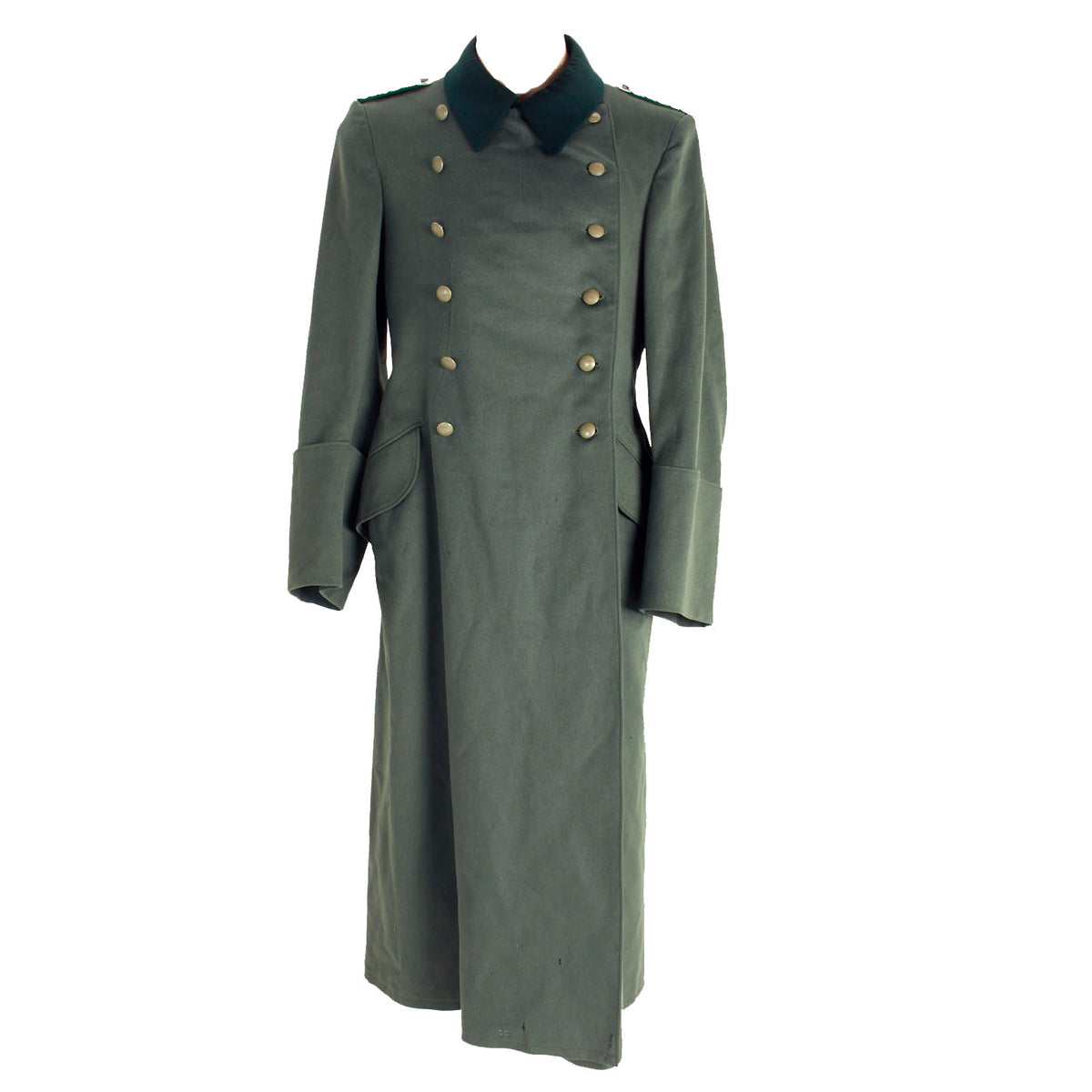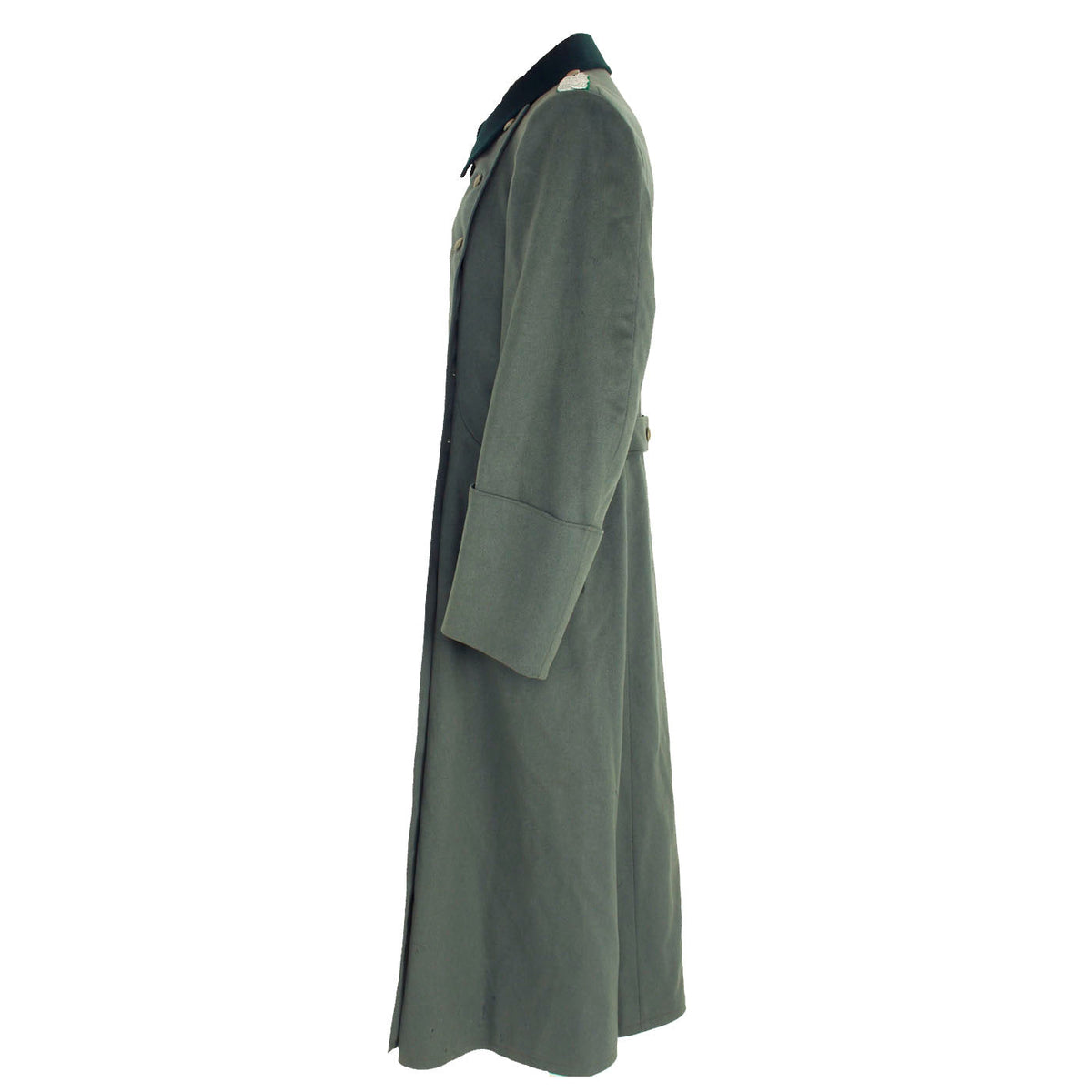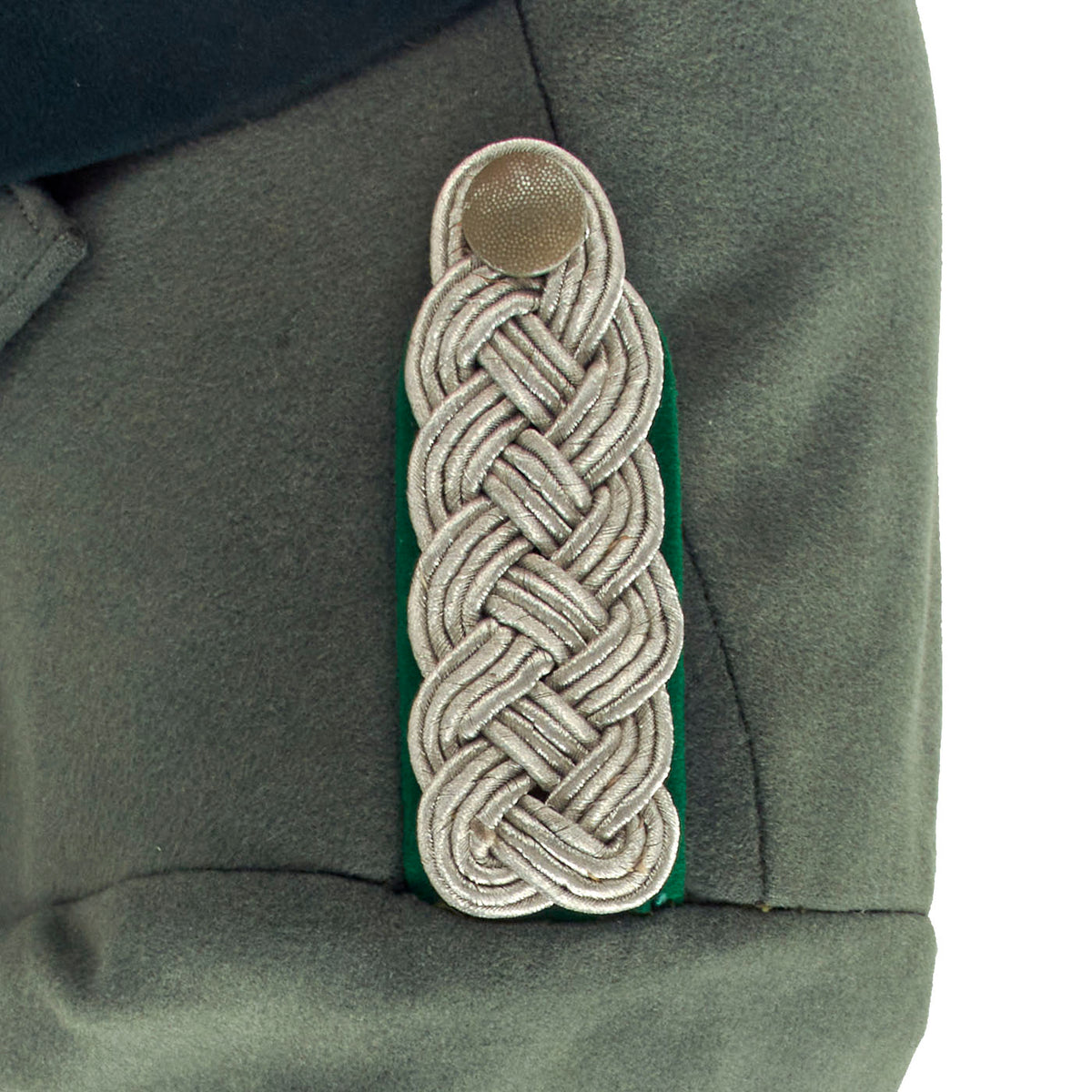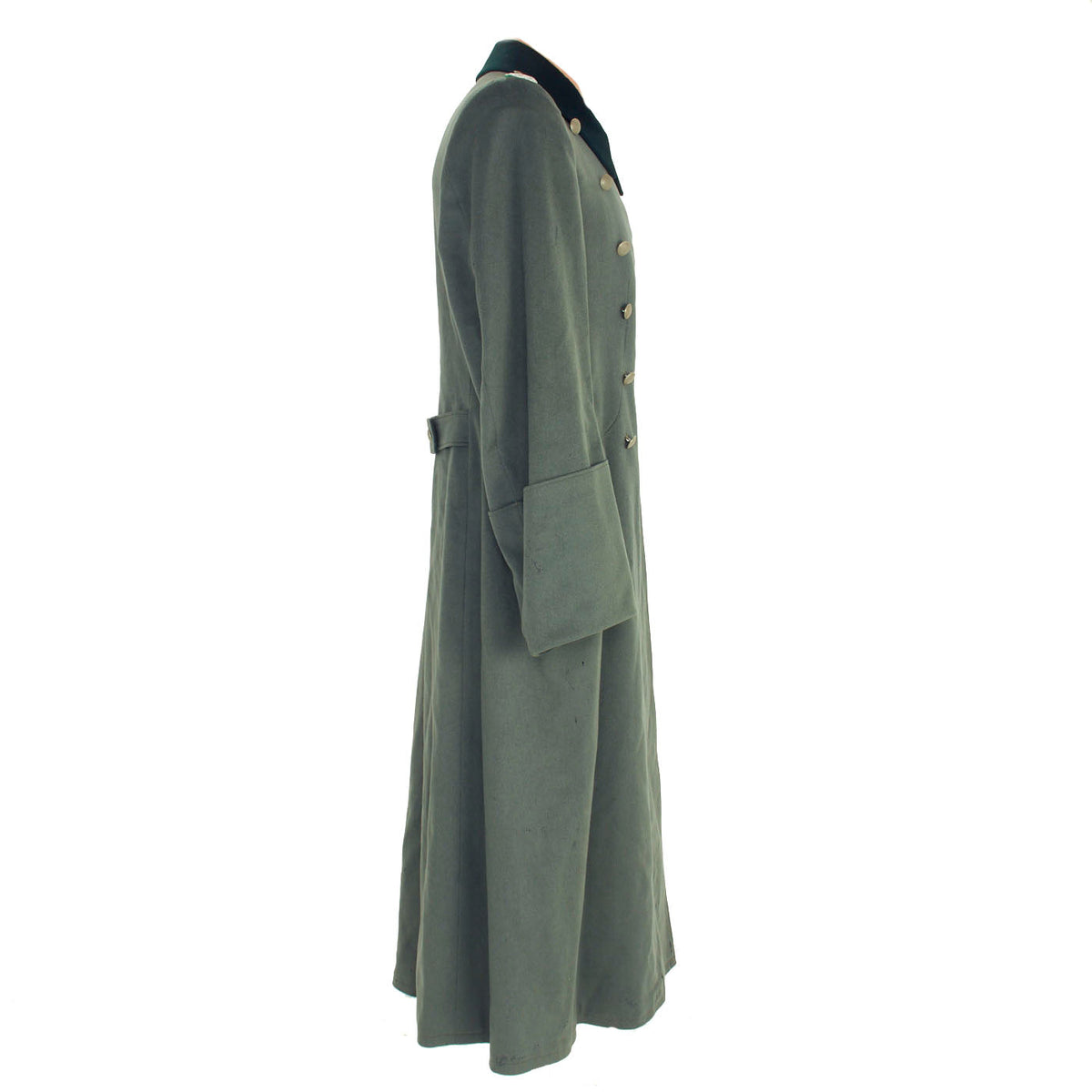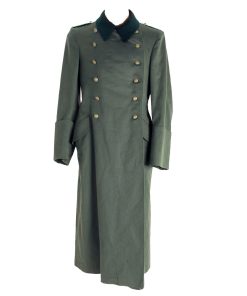Original German WWII German Panzergrenadier Major Officer’s Wool Greatcoat by Michael Hollfelder of Ansbach Original Items
$ 595,00 $ 178,50
Original Item: Only One Available. This is a very nice German WWII Panzergrenadier Officers great coat or overcoat, constructed with an outer shell of heavy feldgrau (field gray) wool. The rear of the collar bears a maker label for Michael Hollfelder of Ansbach, located in Bavaria outside of Nürnberg. There is also a tailor tag on the inside of the left pocket for the same maker, and it looks to have a name on it, which we are not able to read. There is also a date, which looks to be “1942”, but the third number is not clear. The interior of the jacket looks to be rayon, or a rayon blend, and is in very good condition.
The great coat matches very well with the M36 pattern, with a dark green “badge cloth” lay down collar and long cuffs at the end of the sleeves. The front features the correct 12 button front closure, featuring 6 buttons on each side. These are all marked EXTRA FEIN, and some bear the “Barred A” trademark logo of F. W. Assmann & Söhne of Lüdenscheid, a German city known for its clothing accessories industry. This maker is particularly well known, and had other factories as well.
The “sew-in” style Stabsoffizier schulterklappen (Field-grade Officer shoulder boards) of this tunic are constructed with two rows of fine silver flatware “Russia Braid” double piping, which are plaited together to form a loop around the buttonhole. They are in very good condition, and do not have any rank “pips” installed, indicating the lowest staff officer rank of Major, equivalent to the same rank in the U.S. and U.K. armies.
The shoulder boards have the correct Wiesengrün (Meadow Green) colored backing, the Waffenfarbe (corps color) for the Heer Panzergrenadiertruppen (Panzer Grenadier Troops). These were motorized / mechanized infantry troops, and were legendary in the field. Originally called Schützen regiments, they had used the same Pink piping as the Panzer corps. Then in 1942 Infantry Regiments were renamed as Grenadier Regiments by AH as a historical homage to Frederick the Great’s Army, and the Schützen were renamed to Panzergrenadiers.
Condition is very good considering the age, with the colors retained very well, and no major damage, just the usual light staining and wear from service. There are also some areas of light mothing, which are limited to the fuzzy “nap” of the fabric.
This is a great example of a genuine WWII wool greatcoat and would display fantastically.
Measurements:
Collar to shoulder: 10”
Shoulder to sleeve: 26”
Shoulder to shoulder: 16”
Chest width: 18.5”
Waist width: 22”
Hip width: 26”
Front length: 51.5″
Following the invasion of the Soviet Union the Greatcoat was found to be insufficient for the Russian winter and they were replaced by more effective clothing.
Overcoats in various forms have been used by militaries since at least the late 18th century, and were especially associated with winter campaigns, such as Napoleon’s Russian campaign. The full-length overcoat was once again popularized by the use during World War I of the trench coat.
Stereotypically, overcoats used by the army tended to be single-breasted, while navies often used double-breasted overcoats. Overcoats continued to be used as battle dress until the mid-1940s and 1950s, when they were deemed impractical. However, in colder countries, such as the former Soviet Union, they continue to be issued and used. When more efficient clothing and synthetic fibers became readily available, the overcoat began to be phased out even there.
Fast Shipping with Professional Packaging
Thanks to our longstanding association with UPS FedEx DHL, and other major international carriers, we are able to provide a range of shipping options. Our warehouse staff is expertly trained and will wrap your products according to our exact and precise specifications. Prior to shipping, your goods will be thoroughly examined and securely secured. We ship to thousands clients each day across multiple countries. This shows how we're dedicated to be the largest retailer on the internet. Warehouses and distribution centres can be located throughout Europe as well as the USA.
Note: Orders with more than one item will be assigned a processing date depending on the item.
Before shipping before shipping, we'll conduct a thorough inspection of the items you have ordered. Today, the majority of orders will be delivered within 48 hours. The delivery time will be between 3-7 days.
Returns
The stock is dynamic and we cannot completely manage it because multiple stakeholders are involved, including our factory and warehouse. So the actual stock may alter at any time. It's possible that you may not receive your order once the order has been made.
Our policy is valid for a period of 30 days. If you don't receive the product within 30 days, we are not able to issue a refund or an exchange.
You can only return an item if it is unused and in the same state as the day you received it. You must have the item in its original packaging.
Related products
Uncategorized
Uncategorized
Uncategorized
Uncategorized
Uncategorized
Uncategorized
Uncategorized
Uncategorized
Uncategorized
Uncategorized
Armoured Fighting Vehicles of the World: AFVs of World War One (Hardcover Book) New Made Items
Uncategorized
Band of Brothers ORIGINAL GERMAN WWII Le. F.H. 18 10.5cm ARTILLERY PIECE Original Items
Uncategorized
Australian WWII Owen MK1 Machine Carbine SMG Custom Fabricated Replica with Sling Original Items
Uncategorized
Armored Burgonet Helmet & Polearm from Scottish Castle Leith Hall Circa 1700 Original Items
Uncategorized
Uncategorized
Uncategorized
Uncategorized
Uncategorized
Uncategorized
Uncategorized
Angolan Rebel 1970s era 60mm Inert Display Mortar from Angolan Civil War Original Items
